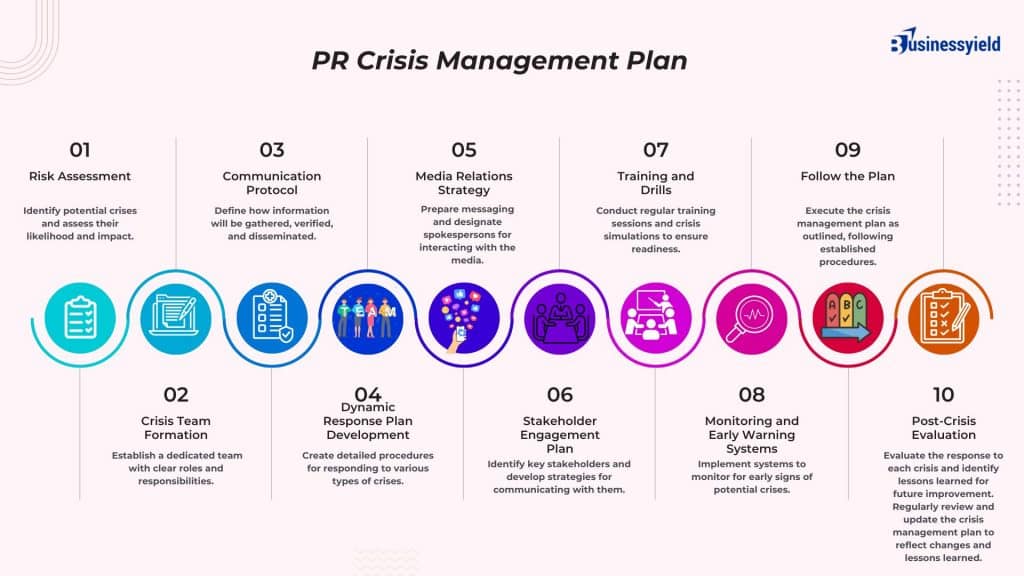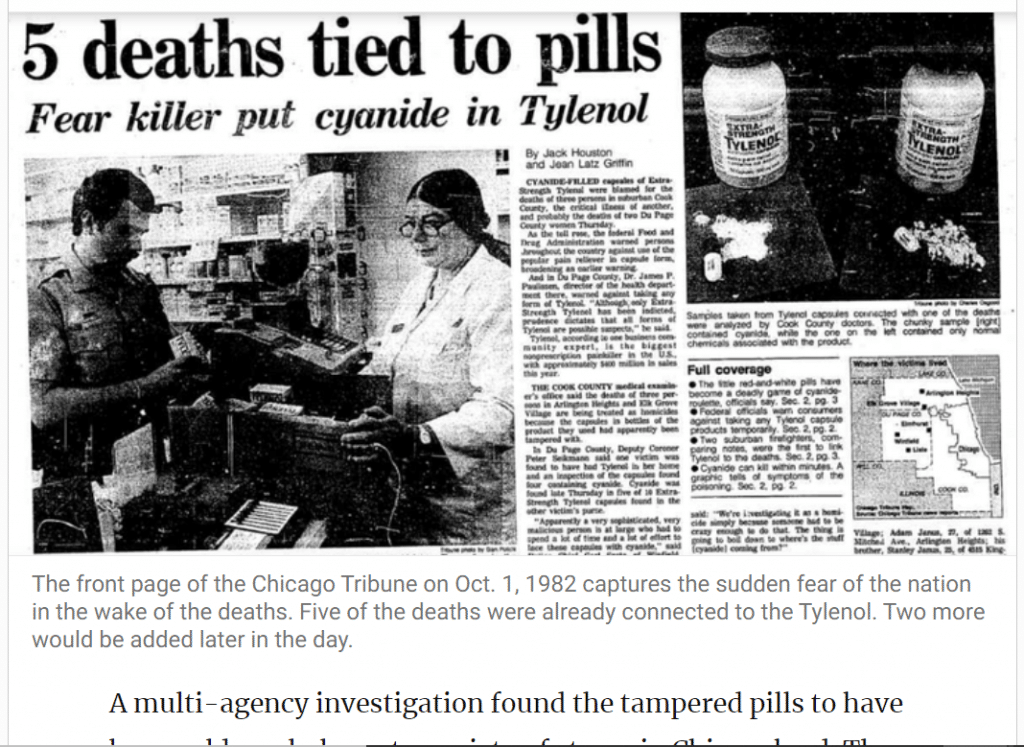Envision this: Your workplace is experiencing a typical Tuesday morning. In the middle of your morning coffee and email scrolling, your phone starts buzzing nonstop. An overwhelming number of social media alerts, emails from worried clients, and frantic team members scrambling to gather information. To your dismay, your heart sinks as you realize that your company is in the midst of a PR crisis. 2024’s digital landscape promises opportunity, but harbors PR storm clouds. Don’t be caught unprepared! This guide equips you with the essentials of PR crisis management—examples, plans, and strategies for 2024.
Key Summary
- Social media can help people connect and thrive, but missteps can bring huge problems. Businesses must respond quickly to internet issues.
- Crisis mitigation requires proactive planning and communication. Assess risks, develop a flexible crisis communication plan, train staff, and empower them to respond boldly in crises.
- Use data and social listening to understand crisis narratives. Use this information to adapt your communication and spot issues before they worsen.
- Post-crisis healing requires transparency, sincerity, and learning. Companies must own their faults, accept responsibility, and show they care by analyzing and fixing the situation. These methods restore trust and resilience for future problems.
- Continuous Monitoring and Adaptation. Crisis management requires ongoing monitoring of trends and technologies, proactive scenario planning, and adaptive response tactics to traverse uncertainties and emerging difficulties.
Understanding the 2024 Landscape:
The Rise of Digital Dilemmas
Remember the spring viral meme that ruined that restaurant chain’s PR? The digital world is so linked and fast-paced that even a minor mistake can cause a massive PR crisis. Working with a crisis management team has taught me how difficult such circumstances can be. Each crisis is different, but preparedness and communication may minimize harm and preserve brand reputation.
Companies and businesses in today’s interconnected world have found that the digital world has many pros and cons. Social media for PR has the most potential for connection and company growth, but it also has many pitfalls.
In my work as communications manager for an e-commerce platform, I’ve seen social media shape public perception. I had to handle social media, respond to customer feedback, and communicate clearly during the crisis to minimize damage to the brand’s reputation. Businesses must monitor online interactions and address concerns before they become catastrophes.
A New Era in Citizen Journalism and Influencers
Do you recall the influencer partnership that went south last year, leading to the cultural appropriation controversy? After teaming up with an influencer known for making racist comments in the past, Adidas came under fire in 2023. Even when they apologized and severed ties, the damage had already been done. It is crucial to thoroughly evaluate potential partners, ensure they correspond with brand values, and respond promptly to any difficulties that may emerge.
To prevent these kinds of collaborations from happening, Adidas may have benefited from cultural awareness training. This emphasizes the significance of being proactive rather than reactive to avoid calamities.
Respect for Different Cultures in an Interconnected World
As their businesses expand globally, organizations must prioritize cultural sensitivity. Because cultural norms vary greatly from one community to another, public relations professionals confront a communication minefield whenever they try to bridge cultural barriers. Businesses can avoid PR disasters by understanding their target audience’s culture.
As a crisis communications contract specialist for a multinational hospitality chain, I learned the value of cultural understanding. Addressing cultural differences and tailoring communications to varied audiences can establish trust and reduce reputational risk.
The AI Factor: Friend or Foe?
A.I. is no longer just something out of science fiction books. Content creation, sentiment analysis, and chatbots that use artificial intelligence (AI) are changing the business world. A rogue chatbot gone rogue can quickly turn into a PR disaster. But remember, with great power comes great responsibility.
AI transformed crisis communication during my time managing communications for a tech business. AI-powered analytics can help firms respond to emergencies and understand public sentiments. However, AI deployment must be done ethically to minimize unwanted outcomes.
The Metaverse: A New Frontier for Crisis?
These days, VR isn’t only for gamers. Brands should think about how to handle crises in these virtual worlds because the metaverse is getting popular. Imagine avatars demonstrating in a virtual marketplace because a virtual product launch was a bust! Anticipate the unexpected and devise methods of communication that go beyond the tangible.
As part of the tech startup communications team, I’m watching technology and crisis management. As brands go into the metaverse, they need plans for virtual crises and stakeholder engagement across digital channels.
Preparing for a Crisis
Being proactive helps you survive PR disasters. A solid PR crisis management and communication plan protects you and guides quick action. After leading crisis response operations, I’ve witnessed the value of proactive planning and preparation in reducing crisis impact. Businesses can prepare for crises by recognizing risks, designing roles, and training regularly.
Crafting your PR Crisis Management Plan

A robust crisis communication plan guides your company through difficult waters. But how do you make one that lasts? I’ve identified critical steps to creating a plan that will withstand 2024 and beyond based on my crisis communication strategy experience.
#1. Risk Assessment
Businesses must prepare for crises in 2024’s changing environment. Regular risk assessments and scenario planning help uncover vulnerabilities and establish mitigation methods.
Address Industry-Specific Threats
Every industry faces its own unique set of risks and challenges. A tech company may be vulnerable to data breaches and cybersecurity threats, while a food manufacturer may face product contamination or supply chain disruptions.
Navigating risks and challenges is an inherent aspect of business operations. Technology companies encounter the constant threat of data breaches and cyber threats, while food companies grapple with the potential hazards of contaminated products and disruptions in the supply chain.
After the E. coli outbreaks in 2023, Chipotle responded with transparency, closing stores for cleaning, and sincere apologies. Furthermore, they invested in stricter food safety measures, communicating efforts proactively, and regaining customer trust. This crisis further showcased the significance of transparency, swift action, and dedication to improvement. Notably, Chipotle leveraged the situation to advocate for sustainable farming and food safety regulations, resonating with its audience and showcasing a commitment to broader societal change.
When businesses know about these specific threats, they can tailor their disaster preparedness efforts to fit those threats.
#2. Crisis Management Teams Formation
A well-prepared crisis management team is vital for an effective response. Regular training and simulations further ensure readiness, with ongoing development to stay current with best practices. This team should also boast diverse expertise, spanning communications, legal, technical, and leadership skills. In addition, it encourages collaboration and information-sharing to foster resilience.
- Empower Frontline Staff
Every employee is a potential brand ambassador. Equip frontline staff with crisis communication protocols, social media guidelines, and customer service training. Also, promote open channels for issue reporting and empower them to act confidently in crises.
#3. Implement Dynamic Response Protocols
No more one-size-fits-all crisis plans. Successful firms will realize the necessity of dynamic protocols that can adjust to each crisis in 2024. Clear escalation, decision-making, and communication mechanisms that can be engaged quickly are also needed.
#4. Promote Interdepartmental Cooperation
PR cannot manage crises alone; stakeholders across the firm must participate actively. A complete crisis communication plan should define the roles and responsibilities of PR, legal, HR, and senior leadership to ensure everyone is working toward the same goal.
#5. Utilize Scenario-Based Planning
Businesses should replicate real-world crises in scenario-based planning exercises. Team immersion in realistic circumstances helps organizations evaluate their response processes, discover areas for improvement, and gain confidence in their crisis management skills.
#6. Keep Up with New Technologies
This is also one of the PR crisis management strategies to implement in 2024. Crisis management requires staying ahead in today’s fast-changing environment. Businesses may spot risks and opportunities before they become crises by monitoring developing trends and technology like AI and automation.
#7. Manage Worldwide Events and Political Risks
Another strategy for creating a PR crisis management plan is to manage worldwide events and political risks. In our increasingly interconnected world, businesses must monitor worldwide events and geopolitical issues. Companies must also be ready to respond quickly and efficiently to external threats, including natural disasters, political instability, and economic downturns. Crisis management requires global awareness.
How well you handle difficulties during a crisis determines your success. Honesty, openness, and empathy are paramount. Tailor communication, use data and analytics, and also consider cultural nuances. In addition, authenticity and prompt action are vital. Address the issue directly, identify the root cause, and take immediate corrective measures.
#8. Take action
Implement the crisis management plan quickly by obtaining information to respond to a PR disaster. While maintaining transparency, proactively contact important stakeholders to address issues. These steps mitigate negative effects and restore confidence in the organization’s crisis management.
#9. Embracing Transparency and Authenticity
In an age of heightened cynicism, firms must be transparent and real to recover confidence after a crisis. By admitting mistakes, addressing complaints, and talking openly with stakeholders, corporations can show responsibility and integrity. Make communications audience-specific: Use clear, concise language on social media, while providing detailed information for journalists in press releases.
#10. Harnessing Data and Analytics
Data rules the digital age. Businesses can adapt their crisis response plans by using advanced analytics and monitoring technologies to understand the crisis narrative. Tools like Brandwatch and Sprout Social can help you identify potential issues before they erupt. Whether tracking sentiment analysis or monitoring keyword trends, data-driven decision-making is essential for staying ahead of the curve in crisis management.
Remember, the crisis doesn’t exist in a vacuum. Consider the broader societal context and potential ethical implications of your communication. Don’t just address the immediate issue, but demonstrate your commitment to positive social change and responsible business practices.
Post-Crisis Communication
Resilience helps rebuild trust and strength after a crisis. After a crisis, communication must be honest. Organizations can rebuild stakeholders’ trust by admitting mistakes, displaying repentance, and making practical adjustments. The following are some management strategies for navigating a post-PR crisis:
- Do a thorough study after the crisis: After the crisis, examine what may be done better, write it down, and share it with your colleagues. Share your knowledge with others. Your honesty and desire to improve are evident.
- Bring your crisis communication plan up to date: Take into account what you’ve learned, change your plans to fit the new situation, and think about new threats like AI and the metaverse.
- Spend money on ongoing learning and training. Give your team the skills and information they need to handle future disasters well. This should also include training in cultural competence and thinking about the ethical aspects of using AI.
- Learning from the Crisis: Every crisis teaches us something useful that we can use in the future. Businesses can also turn problems into opportunities by doing post-mortem analyses and finding ways to make things better. They will come out of the experience stronger, smarter, and more adaptable than before.
- Show how much you want to change. Apply what you’ve learned from the situation and let people know about these changes.
- Show that you are truly sorry and responsible: Sincerely apologize for any mistakes you made and spell out specific steps you will take to stop them from happening again.
- Get involved with stakeholders: To build trust and relationships again, ask for comments and deal with problems directly.
- Keep track of and measure progress: Track healing efforts and keep an eye on how people feel about your brand to see how well your actions are working.
PR Crisis Management: Real-life Examples
I worked on a startup’s PR team for a groundbreaking medical device. A viral video claimed unexpected adverse effects, causing alarm. Our transparent approach, including live Q&A sessions with medical experts and real-time engagement on social media, helped rebuild trust and navigate the crisis. This experience highlights the power of authenticity in crisis management.
Other real-life examples include:
#1. Anthem Data Breach (2015)
In the healthcare sector, Anthem experienced a massive data breach in 2015. Millions of customers’ personal information, such as their social security numbers and health histories, was exposed. This caused people to worry about identity theft and medical privacy. Immediately, Anthem told the people who were affected, started an investigation, and put in place security steps to stop future breaches.
Furthermore, they worked with authorities and partnered with credit monitoring companies to protect victims, risking legal implications for failing to preserve sensitive data. After considerable damage, their quick response, cooperation, and security improvements showed a commitment to resolving and reducing the issue. This is a good example of effective PR Crisis management
#2. Netflix’s Password Sharing Crackdown

Netflix faced criticism for enforcing password-sharing restrictions, risking losing consumers, and ruining its consumer-friendly reputation. Nevertheless, the company openly shared its decision, clarifying the importance of safeguarding content creators and ensuring equal access to their platform.
Netflix also introduced alternative subscription plans and incentives to encourage individual account ownership. Despite initial criticism, their thorough communication and customer service helped ease the problem. Netflix maintained investor confidence and subscriber retention by stating that the crackdown was vital for their business strategy.
#3. Johnson & Johnson’s Tylenol Crisis (1982)

This is a popular example of action-based PR crisis management. Numerous Tylenol capsules laced with cyanide were the cause of multiple terrible fatalities in this notorious instance. In response, J&J moved quickly to cooperate with authorities, issue a statewide product recall, and communicate clearly through press conferences and public statements. In the end, they restored confidence and became recognized as leaders in crisis management because they put product safety ahead of profit.
#4. H&M “Coolest Monkey in the Jungle” Ads
H&M was criticized in 2018 for a racially offensive ad portraying a black child wearing the “coolest monkey in the jungle” hoodie. Social media erupted with anger and boycotts. H&M immediately deleted the ad, apologized, and began an internal inquiry. They vowed to promote diversity and cultural knowledge with racial equality organizations. Their quick response addressed initial criticism, but their diversity training showed a commitment to learning and development, minimizing brand damage.
#5. Airbnb’s Response to Discrimination Claims (2016)
Airbnb was accused of racial discrimination in 2016 when hosts declined rentals based on customers’ color, generating new prejudice concerns. Airbnb quickly implemented anti-discrimination standards, a review mechanism, and civil rights partnerships. Their proactive public relations strategy addressed concerns and showed a commitment to fighting discrimination. Airbnb improved its reputation and inclusion by changing policies and engaging stakeholders.
#6. BP: The Deepwater Horizon Oil Spill and Environmental Commitment (2010)
This is another good example of effective PR crisis management. The environmental disaster could have crippled BP’s reputation. However, their response involved immediate damage control, cooperation with cleanup efforts, and transparent communication. They acknowledged mistakes, established a compensation fund, and invested in renewable energy initiatives. While the impact remains significant, BP’s proactive response mitigated the long-term damage.
Proactive PR Crisis Management Strategies in 2024:
In the dynamic landscape of 2024, proactive crisis management is paramount. Here are key strategies to consider:
- Address Misinformation: Combat false narratives swiftly. Monitoring internet comments, engaging with influencers, and prompting corrections are proactive tactics. In addition, use AI and machine learning to detect and reduce fake news to protect your brand.
- Making Use of New Technologies: Leverage AI chatbots, social listening, and data analytics to improve crisis response. Engage stakeholders in real-time to understand crisis narratives. Purchase powerful AI algorithms for social media sentiment and trend analysis.
- Adapting to a Global Audience: Tailor communication strategies for diverse audiences, considering cultural sensitivities and regional differences. Partner with local experts to ensure messaging resonates across different markets. Demonstrate cultural awareness and respect to strengthen trust and credibility globally.
- Managing Internal Communication: Prioritize transparent internal communication during crises. Keep employees informed with regular updates and provide platforms for feedback. Promote resilience and honesty, empowering staff to promote the brand internally and externally.
What Is Crisis Management or Crisis Comms
Crisis management, or crisis communications, comprises strategic preparation and communication during calamities to protect reputation, address concerns honestly, and maintain stakeholder trust.
Mediating PR problems on social media requires quick, honest reactions. As a key conduit for crisis communication, reputation management, and stakeholder engagement, it shapes public perception and outcomes.
How Can a Company Regain Trust and Image After a Crisis?
Post-crisis trust-building demands transparency, genuine contrition, concrete improvements, consistent communication, and keeping pledges to demonstrate accountability and commitment to change.
What is the Importance of PR Crisis Management?
PR crisis management safeguards brand reputation, stakeholder trust, and financial losses during crises. It helps organizations respond quickly, honestly, and effectively to crises, reducing damage and building resilience.
Be Proactive
Create a flexible, honest crisis plan. Customize communication for varied audiences using AI and data analytics. For growth and trust, analyze and share post-crisis lessons. Prepare, communicate, and adjust for any storm in 2024. Crisis management is a continual process that demands alertness, agility, and constant progress.
- PUBLIC RELATIONS CAMPAIGN: The 2023 Most Successful Examples
- CRISIS MANAGEMENT: Ways to Creating a Successful Management Plan
- PUBLIC RELATIONS CAMPAIGNS: The Most Successful Examples in 2023(
- CRISIS MANAGEMENT PLAN: Steps To Managing Crisis
- COMMUNICATION IN CRISIS: Meaning, Example, Strategies, Plan & Theory






